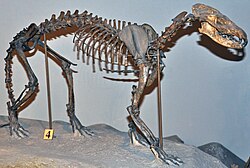Daphoenus
|
Daphoenus Temporal range: 42–16.3 Ma Middle Eocene-Early Miocene |
|
|---|---|
 |
|
| D. vetus skeleton, Carnegie Museum of Natural History | |
| Scientific classification | |
| Kingdom: | Animalia |
| Phylum: | Chordata |
| Class: | Mammalia |
| Order: | Carnivora |
| Family: | †Amphicyonidae |
| Genus: |
†Daphoenus Leidy, 1853 |
| Type species | |
| †Daphoenus vetus |
|
| Species | |
|
|
| Synonyms | |
|
Pericyon |
|
Pericyon
Daphoenus is an extinct genus of caniform carnivoran mammal of the family Amphicyonidae ("bear dogs") of the suborder Caniformia. Daphoenus inhabited North America from the Early Eocene subepoch to the Early Miocene subepoch 42—16.3 Mya, existing for approximately 25.7 million years.
Daphoenus was named by Joseph Leidy (1853). Its type species was Daphoenus vetus. It was assigned to Amphicyonidae by Leidy (1853) and Carroll (1988); and to Daphoeninae by Hunt (1998) and Hunt (2002).
Amphicyonids are discussed in Robert M. Hunt's article Global Climate and the Evolution of Large Mammalian Carnivores during the Later Cenozoic in North America. D. Vetus was the largest of the species. D. hartshornianus, D. lambei (syn. D. demilo), D. ruber, D. socialis, D. transversus, D. vetus (syn. Proamphicyon nebrascensis)
Daphoenus hartshornianus was named by Cope (1873). It was recombined as Protemnocyon hartshornianus by Hatcher (1902); it was recombined as Daphoenus hartshornianus by Scott (1898), Sinclair (1924), Scott and Jepsen (1936), Galbreath (1953) and Hunt (1996). A single specimen was measured by Legendre and Roth in 1988 for estimated body mass. 6.79 kg (15 lb). Daphoenus hartshornianus fossils found in Oligocene Orellan rocks in the Lower Nodular Zone, Pennington County, South Dakota are dated at ~33.4 Ma. Other sites include the Prairie Dog Creek Site and Warbonnet Creek Site, Sioux County, Nebraska ~33.4 Ma., Bartlett High Site, Dawes County, Nebraska ~33.2 Ma., Babby Butte Site, Oglala Lakota County, South Dakota ~33.4 Ma—33.2 Ma.
...
Wikipedia
